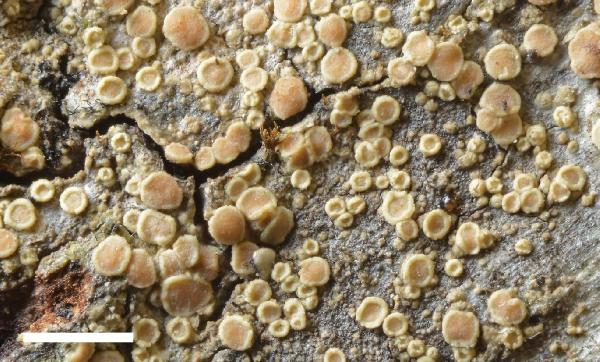Lecanoropsis subsaligna (M. Brand & van den Boom) Ivanovich & Printzen
in Ivanovich & al., Phytotaxa, 695, 1: 47, 2025. Basionym: Lecanora subsaligna M. Brand & van den Boom - in van den Boom & Brand, Lichenologist, 40: 477, 2008.
Synonyms:
Distribution: N - Lig (van den Boom & Brand 2008).
Description: Thallus crustose, endosubstratic or thinly episubstratic, continuous, smooth to slightly warted, whitish to grey with or without a yellow tinge or beige to brown, sometimes with a green hue, forming small patches, often inconspicuous. Upper cortex absent, epinecral layer present, filled with 0.2-3 µm wide, coarse granules; algal cells occupying the whole thallus thickness. Apothecia lecanorine, round to rarely angular, adpressed to sessile, slightly constricted at base, 0.35-0.55 mm across, with a pale beige or yellow-grey to dark brown, epruinose or rarely finely white-pruinose, flat to slightly convex disc and an initially weakly prominent, later level with disc, persistent to rarely finally excluded thalline margin. Thalline exciple corticate, the cortex filled with brownish crystals, (12-)22-40(-53) µm wide laterally, (17-)22-41(-56) µm wide at base; proper exciple poorly developed, when evident 10-35 μm wide, yellowish or brown at the apical gel sheaths, with golden-brown granules on top; epithecium colourless, yellowish brown to dark brown, filled with fine golden brown granules soluble in K, N+ reddish violet; hymenium colourless, (30-)40-60(-85) µm high; paraphyses coherent, simple or sparingly branched and anastomosing, 1.5-2 µm thick at mid-level, the apical cells not or weakly capitate, 2-4.5 μm wide, the gel sheath at apices to 5 μm wide; hypothecium colourless, (35-)40-50(-55) µm high. Asci 8-spored, clavate to pyriform, very thin-walled, with a K/I+ blue, tall tholus penetrated by a faintly amyloid apical cushion, the wall K/I-, surrounded by a blue outer layer, Lecanora-type. Ascospores 1-celled to rarely 1-septate, hyaline, ellipsoid to broadly ellipsoid, (7-)8.5-11(-12) x (2.5-)3-4.5(-6) µm. Pycnidia semi-immersed, brown to colourless in upper part. Conidia of three types: a) 1(-3)-septate, falcate macroconidia attenuated at tips, measuring 20-25 x 1.7-2 µm; b) 1-celled and slightly curved microconidia (rare) measuring 5-10 x 1-2 µm; c) thread-like, curved leptoconidia (not rare) measuring 12-16 x 1-1.5 µm. Photobiont chlorococcoid. Spot tests: thallus K-, C-, KC-, P-, UV-. Chemistry: isousnic acid (major), 7-O-methylnorascomatic acid (traces). Note: a recently-described, lignicolous and corticolous species with a mainly western distribution in Europe (the Italian record is the easternmost one), occurring as a pioneer in species-poor stands. It is closely related to L. albellula and easily confused with Polyozosia hagenii. For further details see van den Boom & Brand (2008) and Ivanovich & al. (2025).
Growth form: Crustose
Substrata: bark and lignum
Photobiont: green algae other than Trentepohlia
Reproductive strategy: mainly sexual
Commonnes-rarity: (info)
Alpine belt: absent
Subalpine belt: absent
Oromediterranean belt: absent
Montane belt: extremely rare
Submediterranean belt: absent
Padanian area: absent
Humid submediterranean belt: extremely rare
Humid mediterranean belt: absent
Dry mediterranean belt: absent

Predictive model

Source: Svensson, M., Ekman, S., Arup, U., Eide Ekman, L., Hammarström, O., Isaksson, R., Jonsson, F., Palice, Z., Vicente, R. & Westberg, M. 2024. Further additions to the Swedish flora of lichenised fungi. Graphis Scripta 36 (2): 15–49. Oslo. ISSN 2002-4495. - CC BY-4.0
typical form with small, pale, plane to convex apothecia without pruina and a
poorly developed thallus (LD-2278771). Bar 1 mm
Growth form: Crustose
Substrata: bark and lignum
Photobiont: green algae other than Trentepohlia
Reproductive strategy: mainly sexual
Commonnes-rarity: (info)
Alpine belt: absent
Subalpine belt: absent
Oromediterranean belt: absent
Montane belt: extremely rare
Submediterranean belt: absent
Padanian area: absent
Humid submediterranean belt: extremely rare
Humid mediterranean belt: absent
Dry mediterranean belt: absent

Predictive model


